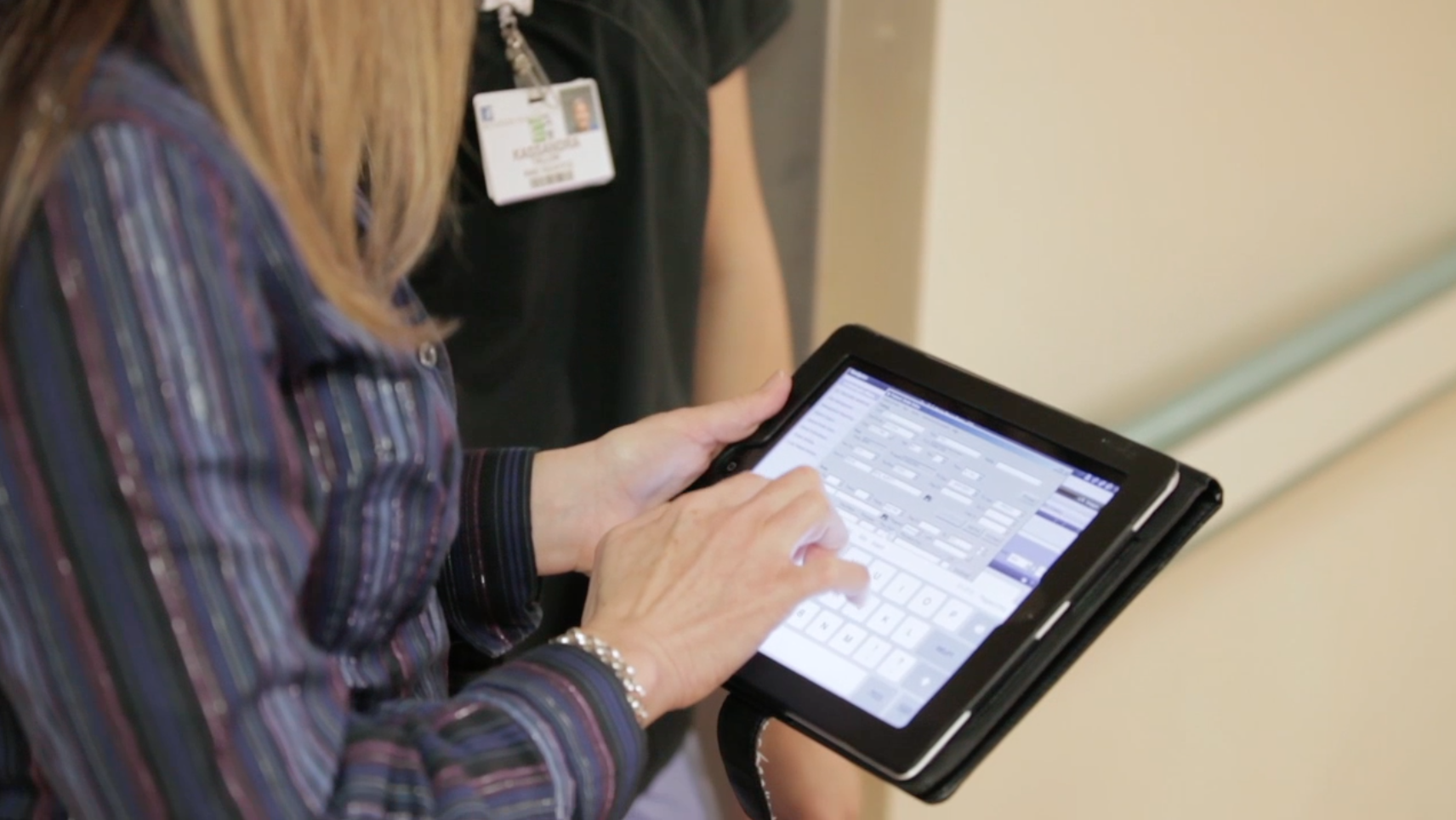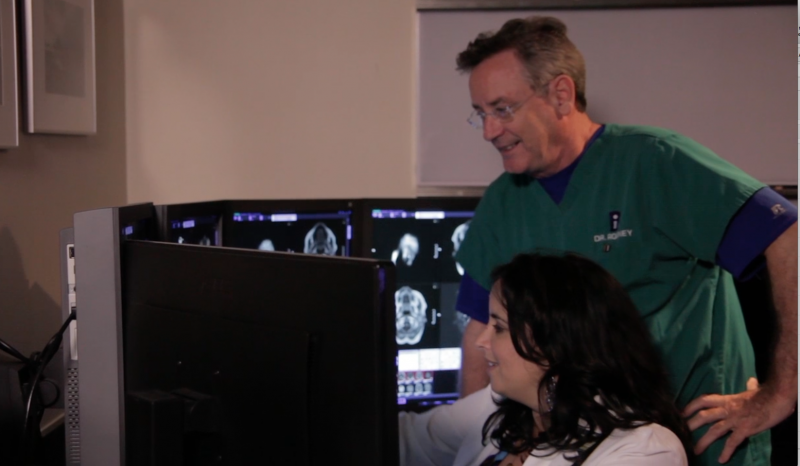
Bethesda RIS/PACS Admisitrator Anne Osowski accessing the system on an iPad.
Bethesda Health in southwest Florida has leveraged its picture archiving and communication system (PACS) to improve medical imaging workflow and efficiency. This has led to cost savings, shortened turnaround times (TAT) and improved analytics to enable better business management. Bethesda Health is based in Boynton, Fla., and includes Bethesda Hospital East and West hospitals with a total of 481 beds, plus the Bethesda Health Urgent Care.
The Bethesda Health system has used a Siemens PACS since 2000, and went through two upgrades with the vendor to its current syngo.plaza system. “We have such a great relationship with Siemens, we really wanted to work with them,” said Anne Osowski, RT(R)(M), RIS/PACS administrator for Bethesda Health. “We never even considered looking at another vendor.”
As with any transition to a new PACS, there are some issues with integrating data, but she said it really boils down to how a vendor addresses those issues. “There are always hiccups moving from one system to another, but Siemens has been outstanding at making sure our PACS integrates all the data we need in one place,” Osowski said.
Improving Interoperability
Bethesda has imaging systems from GE Healthcare, Toshiba, Shimadzu, Carestream, Philips and Agfa, a mammography management system from Hologic, and a Fujifilm cardiology PACS. Patient data from all these systems is now integrated into the Siemens PACS.
“It does not matter where we send our images from, the PACS integrates with all of these systems very well,” Osowski explained. “The seamless integration between the RIS, PACS, hospital information system (HIS) and 3-D software is a key enabler for the important workflow improvements we made.”
With full integration of RIS, PACS, speech recognition, EMR access, HIS and advanced visualization into one workstation, Osowski said the PACS has become a universal image and patient data viewer. The new workflow model now enables access to the EMR and ancillary systems to collect and aggregate patient data, so all resources are optimally used. The system is also decentralized, so the PACS is accessible anywhere via Web-enabling, including from the radiologists’ homes, any of the hospital or clinic locations, and even on mobile devices for immediate consultations. The use of mobile devices in the emergency room in particular has been a great workflow facilitator. Tablets in the ER enable efficient patient interaction and are used primarily for pregnancy and other consent forms.
The PACS also uses a global worklist created by the workflow module for all studies from all modalities. These exams can be assigned to specific radiologists by drag-and-drop into their personal worklists. Or, Osowski said radiologists can jump in when they have completed their work to help read the studies in the queue, regardless of which facility they are for.
“It is not location centered, so no one has to sit at one workstation to read studies for one modality and then move to another to read other studies. Now they can read from anywhere,” Osowski said.
The true test for any PACS is how well it is received by the clinicians and doctors who use it. Bethesda’s radiologists are big fans of their system and have found referring physicians are the biggest users of the mobile/remote viewing capability.
“The unified worklist is accessible at any of our locations and is a big time saver,” said Bethesda radiologist Ariana B. Alvarez, M.D., who specializes in breast and chest imaging. She said other major workflow efficiencies include integration with speech recognition software for immediate conversion to text in the report, and the integration of the advanced visualization software into all workstations.
Alvarez added that the RIS/PACS now automatically flows patient data that was not previously available when a study was opened. This includes ages of the patients, radiation dose and IV contrast doses used. For mammography, it includes the dates of prior mammograms for easier access and the patient BI-RADS score for automatic patient letter assignment.
Speeding Workflow
Today, most of the top PACS offer similar tools and functionality, so the key differentiator is workflow and ease of integration.
“It’s the integration with a workflow module that makes the difference in today’s PACS,” Osowski said. “The Siemens system is very efficient.” She said this is because of the deep integration and single login for all the IT components combined into one workstation.
She said six radiologists read about 600 exams a day. “I had one radiologist this past weekend who read about 300 exams in one day, so this system needs to be efficient,” Osowski explained.
One of the big goals for Bethesda is to lower its radiology turnaround times. By leveraging a workflow module in combination with PACS and data analytics, Bethesda succeeded in cutting TAT by 12 hours. This was accomplished with a mix of analytics to gather statistics, with the integration of speech recognition software and the global worklist. Speech recognition-based reporting allowed radiologists to immediately auto-complete and edit their reports without the need for transcription services.
“We were able to replace transcription services within six months and we save $100,000 per year,” Osowski said. “It has made a major impact on our cost savings.”
She explained this was largely driven by one radiologist who quickly adopted using the technology to rapidly complete his reports, which allowed him to leave work earlier. This inspired other radiologists to follow his example.
“It’s so much better, there is just no comparison,” Alvarez explained. “It completes the text in the report automatically and you can immediately see if you forgot something, like the body part being examined.”
Osowski shared one example of the impact of the speech recognition integration on TAT, where a pulmonologist returned from a surgical procedure and found the post-op imaging report for that patient already completed on his desk. She said he was amazed.
Improved, Intuitive Advanced Visualization
In the old days prior to Bethesda’s current PACS, a radiology technologist had to use a dedicated advanced visualization workstation to slice and dice images and prepare them for a radiologist’s review. At Bethesda West Hospital, 12 miles across town, there was no dedicated workstation, so the radiologist had to call techs at Bethesda East to create the image renderings. The main use of 3-D imaging at Bethesda is for CT spine and CT chest or cardiac exams, which sometimes required several revisions. Needless to say, 3-D imaging was not heavily used in the past because it was cumbersome to access and time-consuming. However, with the newest PACS upgrade, anyone using the system has immediate, one-click access to the syngo.via advanced visualization software.
“Now everything can be seen on one workstation, which cuts a lot of time,” Osowski explained. “The radiologists use it a lot more now than they used to. Also, the use of CT angiography skyrocketed when we added an easy-to-use vascular package for cardiac CTAs. The tech use of advanced visualization has also gone up astronomically now that they have it on their workstations.”
She explained the intelligent vascular software automates many of the renderings and quantifications on CTA studies, including centerline tracing, ejection fraction, stenosis measurement and highlighting calcium to speed calcium scoring. “Techs used to do this and it would tie them up for 20-30 minutes per study, and now the automation is immediate and it does a better job than any technologist could do,” Osowski said.
“It has drastically reduced our CTA turnaround times by three to five hours,” Alvarez explained. She said the biggest benefit of the CTA app is that all the radiologists now have immediate access to it and it is very intuitive to use. “We just did not have the manpower before and it required technologists to leave their desk to create the reconstructions. Now, we can do it in just a few clicks.”
If there were a question on a CTA reconstruction prior to the new software/PACS integration, the radiologists would have to call in a technologist to help walk them through the coronaries. Today, Alvarez said she can easily navigate the 3-D datasets herself.
Osowski said this has freed up the techs so they now spend more time scanning patients. The efficiencies gained resulted in cutting TAT for CTAs from five hours to 2.27 hours, Osowski said. “Now I am back to running two CT scanners full time in the emergency room and not having a tech tied up and out of the department working on CTA scans with the radiologist,” she explained. “For me, getting the techs back is priceless.”
Enabling Deeper Analytics
The Siemens Workflow solution is a Microsoft SQL server-based system, so Bethesda is able to use SQL Server Reporting Services to pull analytics reports. Osowski said SQL Server has made it much easier to search analytics data points than previously.
For lowering TAT, she said analytics were key to allow managers to identify any reporting bottlenecks. This included capturing data from the workflow management system on the time a patient arrived in the department, time to scan, wait times and time to read the study.
Analytics also were used to quantify the loss in productivity when four of the techs where being used in the operating room on a regular basis.
Data-mining was used to help locate subtle workflow issues. For example, Osowski keeps benchmarks for several workflow indicators, including time to open studies, so they can easily identify if there is a system slow down. She said these benchmarks have been helpful in showing Siemens any technical issues. In one case there was an automated backup program running in the background, which was changed to run during off-peak hours.
Bethesda closely tracks its workflow to measure workflow performance and to see how the radiology department can make adjustments in staffing to become more efficient. A major goal over the past year was to reduce emergency room (ER) turnaround times.
“We set a goal that we wanted all ER CT scans completed within 30 minutes. We looked at how we needed to increase staffing during certain times and we accomplished that. If you can get these exams done and read faster, you can discharge your patients faster,” Osowski explained. This is important in a fee-for-value healthcare delivery model and increases patient satisfaction with the radiology service line.
Based on analytics, the health system changed its technologist start times after reviewing peak times for orders and observing bottlenecks in the late afternoon. The data show more orders come in well after the staff has already started the day, and the issues late in the day were due to staff going home. “So, we asked ourselves if we really needed staffing at 7 a.m., when most of the orders are not in yet and it made more sense for techs to come in later,” Osowski said.
Another application of analytics has been for hospital marketing efforts aimed at referring physicians. Osowski can pull all the referral order data by zip codes of patients, exam type and who the referring physician was. This allowed the health system to create maps showing where referrals are strong or weak, so it knows where to concentrate referral physician marketing efforts.
“It used to be extremely time-consuming and I did not have that information, but now I can see if we are missing referrals,” Osowski concluded. Referral management is an essential element of population health management initiatives.
Standards-based interoperability and integration between disparate clinical information and imaging informatics solutions have shown to be instrumental for improving workflow, quality and productivity, all this while decreasing cost and improving both provider and patient satisfaction.
Case study sponsored by Siemens Healthineers.



 April 22, 2024
April 22, 2024 








